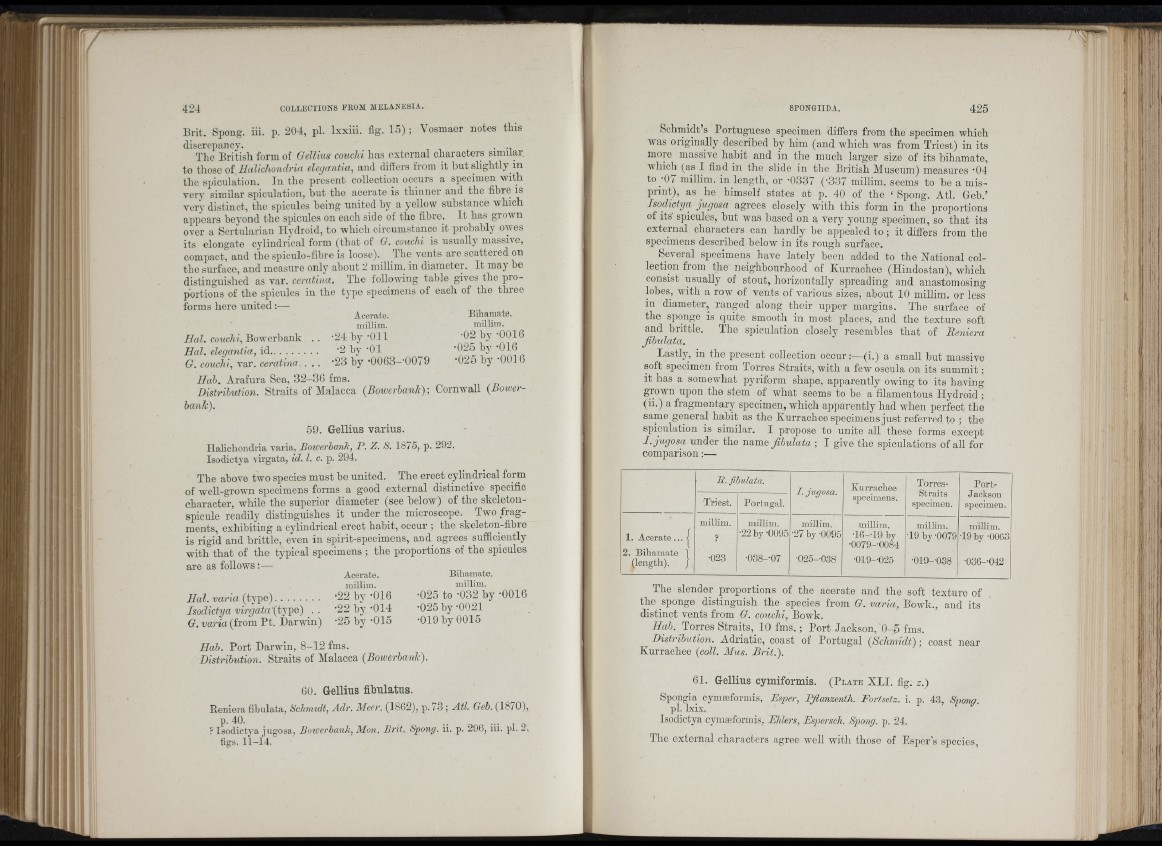
m k •Ih
i l
:i ]■ I Ili
!fi ;: !
lU i
I ■ • t:
:• iü
^1 'J 1i-1
M i it '■
ì ■-[ --Á
! l
s
i i f
i
e r ;
: Î
i ;
li! I
M
c I
i l
Brit. Spoug. iii. p. 204, pi. Ixxiii. fig. 1 5 ); Vosmaer notes this
discrepancy. .
The British form of Gellius couchi has external characters similar
to those of i/aZicAoacZria elegantia, and differs from it hut slig h tly /n
the spiculation. In the present collection occurs a specimen with
very similar spiculation, but the acerate is thinner and the fibre is
very distinct, the spicules being united by a yellow substance which
appears beyond the spicules on each side of the fibre. I t has grown
over a Sertularian Hydroid, to which circumstance it probably owes
its elongate cylindrical form (that of 0 . couchi is usually massive,
compact, and the spiculo-fibre is loose). The vents are scattered on
the surface, and measure only about 2 millim. in diameter. I t may he
distinguished as var. ceratina. The following table gives the proportions
of the spicules iu the typo specimens of each of the three
forms here united :—
Acerate.
millim.
•24 by -Oil
•2 by -01
•23 by -0063--0079
Hal. couchi, Bowerbank
Hal. elegantia, id.............
G. couchi, var. ceratina. .
Bihamate.
millim.
•02 by -0016
•025 by
■016
•025 by
•0016
Hah. Arafura Sea, 32-36 fms.
Distrihution. Straits of Malacca (Bowerhank); Cornwall (Boiverhank).
59. Gellius varius.
Halichondria vaiia, Bowerhank, P. Z. S. 1875, p. 292.
Isodictya virgata, id. I. c. p. 294.
The above two species must be united. The erect cylindrical form
of well-grown specimens forms a good external distinctive specific
character, while the superior diameter (see below) of the skeletonspicnle
readily distinguishes it under the microscope. Two fragments,
exhibiting a cylindrical erect habit, occur ; the skcleton-fihre
is rigid and brittle, even in spirit-specimens, and agrees sufiiciently
with th a t of the typical specimens ; the proportions of the spicules
are as follows :—
Acerate.
millim.
Hal. varia (ty p e )................ -22 by -016
Isodictya virgata (t^ge) . . ’22 b y -014
G. varia (from Pt. Darwin) -25 by -015
Bihamate,
millim.
•025 to -032 by -0016
•025 b y -0021
•019 by 0015
Hah. Port Darwin, 8-12 fms.
Distrihution. Straits of Malacca (Bowerhank).
60. Gellius fihulatus.
Reniera fihulata, Schmidt, Adr. Aleer. (1862), p. 73 ; Atl. Geh. (1870),
p. 40. .. . ••• 1 o
? Isodictya jugosa, Bowerhank, Mon. Bnt. Spong. ii. p. 296, iii. pi. -j.
figs. l ì -14.
Schmidt s Portuguese specimen differs from the specimen which
was originally described by him (and which was from Triest) in its
more massive habit and in the much larger size of its bihamate,
which (as I find in the slide in the British Museum) measures ‘04
t o -07 millim. in length, or -0337 (‘337 millim. seems to be a misprint),
as he himself states at p. 40 of the ‘ Spong. Atl. Geb.’
Isodictya jugosa agrees closely with this form in the proportions
of its spicules, hut was based on a very young specimen, so th at its
external characters can hardly be appealed t o ; it difiers from the
specimens described below in its rough surface.
Several specimens have lately been added to the National collection
from the neighbourhood of Kurrachee (Hindostán), which
consist usually of stout, horizontally spreading and anastomosing
lobes, with a row of vents of various sizes, about 10 millim. or less
in diameter, ranged along their upper margins. The surface of
the sponge is quite smooth in most places, and the texture soft
and brittle. The spiculation closely resembles that of Reniera
fihulata.
Lastly, in the present collection occur:—(i.) a small but massive
soft specimen from Torres Straits, with a few oscula on its sum m it;
it has a somewhat pyriform shape, apparently owing to its having-
grown upon the stem of what seems to be a filamentous Hydroid ;
(ii.) a fragmentary specimen, which apparently had when perfect the
same general habit as the Kurrachee specimens ju st referred to ; the
spiculation is similar. I propose to unite all these forms except
I . jugosa under the name fibulata ; I give the spiculations of all for
comparison:—
R. fihulata.
I. jugosa. Kurrachee
specimens.
Torres-
Straits
specimen.
Port-
Jactson
'Triest. Portugal. specimen.
1. Acerate... |
2. Bihamate ]
(length). /
millim.
9
•023
millim.
•22 b y 0095
•038--07
millim.
•27 by -0095
•025--038
millim.
•16--19 by
•0079--0084
•019--025
millim.
•19 by -0079
•019--038
millim.
•19 by -0063
•036--042
The slender proportions of the acerate and the soft texture of
the sponge distinguish the species from G. varia. Bowk., and its
distinct vents from G. couchi, Bowk.
Hah. Torres Straits, 10 fm s .; Port Jackson, 0-5 fms.
Distrihution. Adriatic, coast of Portugal (Schmidt) ; coast near
Kurrachee (coll. Mus. Brit.).
61. Gellius cymiformis. ( P l a t e XLI. f ig . z.)
Spongia cymæformis, Esper, Pflanzenth. Eortsetz. i. p. 43, Spong.
pi. Ixix.
Isodictya cymæformis, Ehlers, Espersch. Spong. p. 24.
The external characters agree well with those of Esper s species,
: ;r
tri):
ri;: 1
t t
ili
Ite: H., i-
, I
: í »